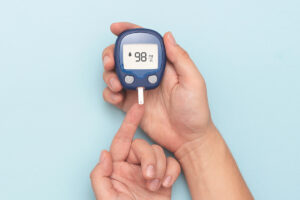 If you’ve been diagnosed with diabetes, getting your blood sugar under control is imperative. It not only can mean the difference between life and death, but also the difference between vision and blindness. Dr. George . G. Khouri of Palm Beach Eye Center explains the various ways in which uncontrolled blood sugar can damage vision.
If you’ve been diagnosed with diabetes, getting your blood sugar under control is imperative. It not only can mean the difference between life and death, but also the difference between vision and blindness. Dr. George . G. Khouri of Palm Beach Eye Center explains the various ways in which uncontrolled blood sugar can damage vision.
1. Diabetic Retinopathy
Uncontrolled blood sugar levels may damage the retina — that’s the layer of tissue covering most of the back of the eye — resulting in diabetic retinopathy. The retina receives light that is focused from the lens and then sends visual information to the brain. Diabetic retinopathy affects blood vessels in the retina. The damaged blood vessels swell and leak, and new, abnormal blood vessels develop. This disease can cause vision loss and blindness.
For diabetics, diabetic retinopathy is the primary cause of vision loss. Usually, both eyes are affected. While there are no symptoms in the earliest stages, as the disease progresses patients may experience difficulty reading, blurry vision, impaired color vision or floaters (i.e. cobweb-like streaks that appear in the visual field).
Treatment includes laser therapy for blood vessel cauterization. Other options include vascular endothelial growth factor (VEGF) inhibitors, which prevent the formation of new abnormal blood vessels.
2. Diabetic Macular Edema
Diabetic retinopathy can result in other serious eye issues. This includes diabetic macular edema (DME). This condition causes fluid leaking from blood vessels to accumulate in the retina. The central part of the retina, the macula, swells. Central vision loss may result.
While there is no permanent cure, prompt diagnosis and treatment can effectively treat DME and restore vision if the patient seeks care early enough.
3. Glaucoma
Diabetics are twice as likely to develop glaucoma as those not afflicted with the disease. Glaucoma causes optic nerve damage. The optic nerve connects the brain and eyes. Partial or complete vision loss may occur.
Of the two forms of glaucoma, about 90 percent of case are open angle. In open-angle glaucoma, fluid drains slowly through the drainage angle, and intraocular pressure increases gradually. The less common angle-closure glaucoma occurs when the iris bulges, blocking the drainage area between this colored part of the eye and the cornea. This is a medical emergency, as intense pressure results from the inability of fluid to circulate through the eye.
Early-stage glaucoma is often asymptomatic. As glaucoma progresses, symptoms may include:
- Eye pain in the case of angle-closure glaucoma
- Peripheral vision loss (usually in both eyes)
- Blind spots
4. Cataracts
Cataracts, the clouding of the lens, is another eye condition for which diabetics are at an increased risk. While common in most people ages 65 and up, cataracts in diabetics tend to develop at a younger age. The good news is that cataract surgery can replace the damaged lens with an artificial one.
Contact Us
A diabetes diagnosis changes your life. Careful management is the key to living with this condition. Part of that management is undergoing regular eye examinations to detect any diabetes-related vision changes. For more information, contact Palm Beach Eye Center today and schedule a consultation.









